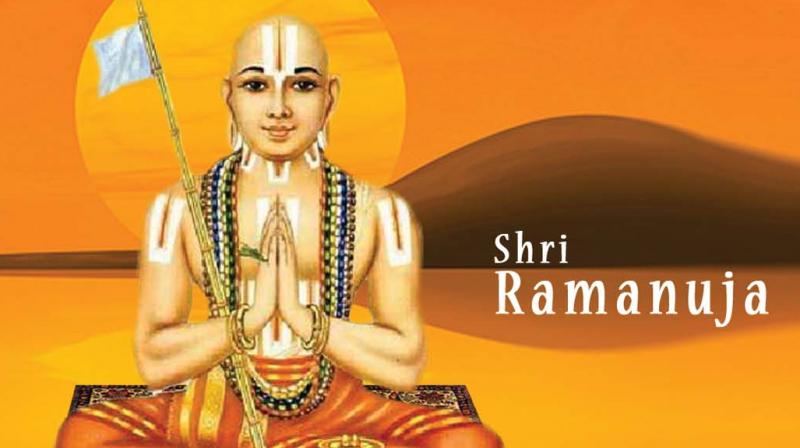Contemporary relevance of two millennial-year thought leaders
Why inclusive visions of Sri Ramanuja and Abhinavagupta matter even more today.

CHENNAI: The 17th century Dutch philosopher Spinoza, said to be polishing lenses when he was not doing philosophy, is credited with this unforgettable quote, “all things excellent are as difficult as they are rare.”
Going by that criterion, it is a indeed very rare and special occasion that the 1000th year of two of India’s most outstanding philosopher-reformers, Sri Ramanuja (C. 1017-1137 CE) and Abhinavagupta (C.950-1016 CE, some versions have it as C. 950-1020 CE) is being celebrated, even if for different reasons, as India steps into its 70th year of Independence.
The millennial year of Ramanuja, born in Sriperumbudur in modern Tamil Nadu, slated for a grand finale in the third week of April 2017, caught the popular imagination fairly rapidly thanks to a long and unbroken ‘Bakthi’ tradition of ‘Vaishnavisim’ in South India.
Abhinavagupta, a philosopher and aesthete, born in Kashmir, has had to slog a bit to get into the limelight to mark the 1000th year of him, as scholars say, having put pen to the bark (no paper then) to write what was to be his greatest philosophical work, ‘Reflections on the Recognition of the Lord (Iswarapratyhabigna-Vimarsini)’.
Notwithstanding the extreme ecological/time zones that separated Ramanuja and Abhinavagupta — incidentally Ramanuja’s first teacher in Kancheepuram was Yadava Prakasa, an ‘Advaitin’ by faith and Abhinavagupta more identified with the Advaitic tradition of Kashmir Shaivism — both the great thinkers had converging undercurrents that reflected an enormous unity in the inclusive, visionary sweeps they brought about.
The ‘cultural appropriation’ by today’s ‘Hindutva forces’ of both Ramanuja and Abhinavagupta may tell a different story. But a relook at their basic tenets of reflective thought bring out their contemporary relevance, their acceptance of diversity and inclusiveness, which the late philosopher-president Dr Sarvepalli Radhakrishnan once said has always informed the ‘ethos of India’. In modern times, it refers to the idea of composite, pluralistic India, as embodied in the Indian Constitution.
Significantly, both Ramanuja and Abhinavagupta were very traditional in taking forward the ‘Vedic tradition’ of knowledge. Yet, both were open to change, philosophically taking on the ‘Advaitic hegemony’ on the one hand, critiquing the doctrine of ‘Maya (illusion)’ in affirming it is a very real world we are living in; on the other, both in the context of social action, smashed the barriers of caste and gender in saying ‘mukthi (liberation) is open to all classes of people, irrespective of caste and creed.
Ramanuja’s genius lay in synthesising the mystic insights of the Tamil ‘Prabandham’ tradition of the ‘Alwars’, giving it the status of a ‘Ubhaya Vedanta’, with the revelatory core of the ‘Vedas’ and wisdom of the ‘Upanishads’ and ‘Bhagavad Gita’, to systematise what came to be known as ‘Vishistadvaita’ system of philosophy.
And in translating them into practice, most scholars are agreed that the number of reforms he introduced in temple rituals, his voluntary acceptance of a non-Brahmin teacher Tirukkachchi Nambi, and his bold propagation of a ‘closely guarded sacred Mantra’ to people of all castes from the temple wall at Tirukkottiyur, in modern Sivaganga district, were “certainly revolutionary for his times”.
That was Ramanuja’s inimmitable way of universalising and secularising the concept of ‘Moksha’, a feat that Abhinavagupta accomplished from within a predominantly more ‘Tantric framework’ of comprehending the ultimate Godhead and creation through the ‘triadic Sakthis or energies’.
In fact, Abhinavagupta’s contributions was excellently put in perspective by Prof. K.D. Tripathi of the Benaras Hindu University, at a recent national seminar here to commemorate the 1000th year of “great philosopher, Tantric thinker and yogin and exponent par excellence of Indian theory of Art,” at Kalakshetra, Chennai, thanks to the efforts of one of our foremost Bharatnatyam exponents Dr. Padma Subrahmanyam.
In carrying forward the Indian knowledge tradition, Prof. Tripathi pointed out that Abhinavagupta had developed his “unique hermeneutical approach” to the understanding of different ‘Shastric texts’ and in fact, “entire Vedic and Agamic tradition attains its peak in his writings.”
The ‘Agama’ as a ‘means of knowing reality’, and ‘Tantra’ and ‘Yoga’ as a means of broad-basing the ‘Vedic’ tradition in which ‘intuition’ plays a key role, was central to Abhinavagupta’s contributions, known as the ‘Trika’ system.
By engaging with all preceding traditions of Indian philosophy including Adi Shankara, “Abhinavagupta offers an alternative to the philosophical views of Acharya Shankara,” argues Prof. Tripathi.
Significantly, Ramanjuja’s approach was similar, offering ‘Vishistadvaita’ as an alternative to Shankara’s ‘Mayavada’. Thus both affirmed that God was very much part of a “real” material world, yet each entity and the Godhead maintained their respective identities.
Dr Padma Subrahmanyam herself acknowledged at the seminar that her long over 50-years study of ‘Karnas’ in Bharatamuni’s ‘Natyasastra’ would not have broken new ground — that the ‘Karnas’, as units of dance, are not ‘static postures’ but each one is a ‘movement’ in the expression of dance itself — if not for the perspective she gleaned after the study of Abhinavagupta’s commentary on the ‘Natyasastra’.
If Ramanuja’s metaphysics eventually took one to ‘prapatti’ (total surrender to the will of God or destiny), Abhinavagupta’s worldview opened up the possibility of transcending one’s limitations through art. Their philosophies were not divisive, and herein lies the eternal relevance of both these thinkers in a highly divisive world today.
